The Temples of Angkor – Celebrity, Factoids, and Vacations
In the world of marketing, celebrities are the advocates de choix. David Beckham did it for Pepsi, Michael Phelps for Speedo, and Kate Moss for Chanel. Destinations are no different, the Lords of the Rings & Middle Earth popularised New Zealand to the tune of $700 million in additional tourism revenue.
Cambodia’s personage came in the form of Angelina Jolie in her leading role in the action and adventure film, Tomb Raider. Its opening scenes are set at the iconic temples of Angkor – after being airlifted in by the British Special Service, of course – and much of the footage focuses on the temples complex of Ta Prohm and Angkor Wat.
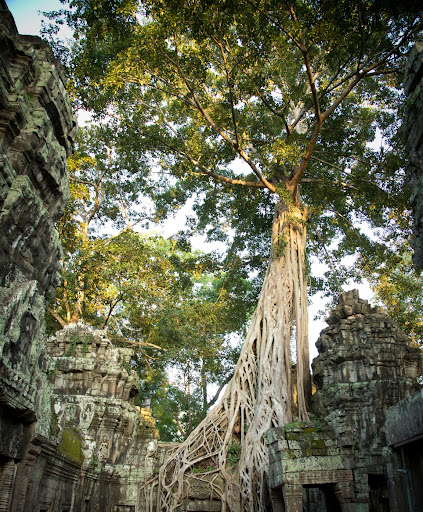
trees of Ta Promh
The resultant fame bestowed upon the temples was palpable. Yet, outside of cinema, little is known about the temples glorious past and recent turbulent history. Where the UK’s Stonehenge is threatened by roadworks and unruly evangelical Pagans, throughout the 1970’s and 1980’s the temples of Angkor witnessed ferocious fighting between the Government and rapacious Khmer Rouge forces, it has suffered insurgencies, lootings, natural disasters and warring empires.
Having visited the temples on two separate occasions, once as a backpacker and once as part of a small group vacations through Cambodia on which we had a tour leader and expert local guide. From this second visit, I found the more I knew about the destination the better the experience.
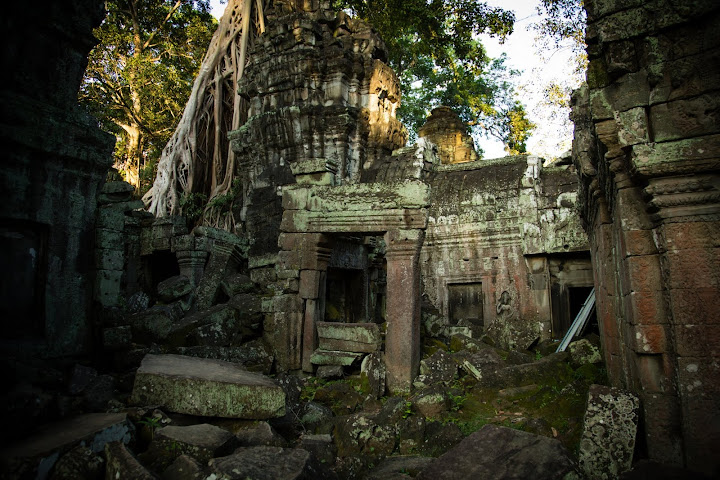
Ta Prohm doorway
So, with this in mind here is my brief synopsis of factoids on Angkor to get you thinking about a visit to The Kingdom.
- Built over 500 years from the 9th century, the ancient city of Angkor was administered by 22 separate reigning monarchs. At its height the Khmer Kingdom ran from Burma in the north the Vietnam in the west, making it one of South East Asia’s largest ever empires.
- Built by King Suryavarman the 2nd in the early 12th century, Angkor Wat is the centrepiece of this massive city, which occupies a landmass greater than modern day Paris or the five boroughs of New York.
- At its height the city of Angkor was home to over 750,000 people.
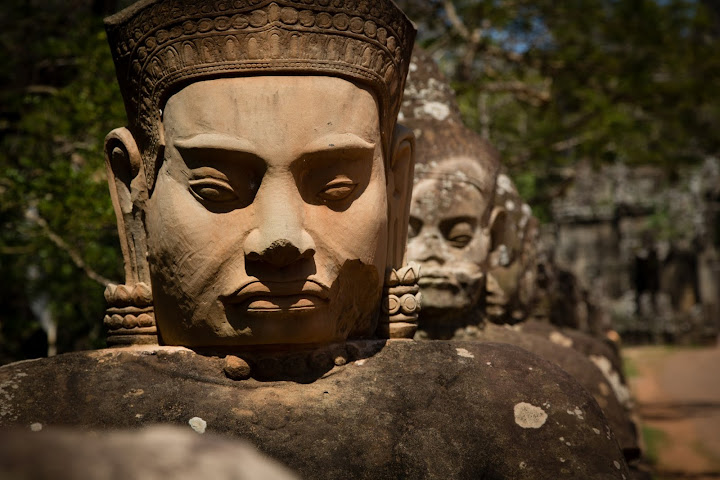
Demons at Angkor Thom
- Visitor numbers to the temples have swollen, going from just a few thousand each year in the 90’s to over 640,000 in the first three months of 2012 alone.
- The ancient Khmers' ability to tame the thick jungle is regarded as a colossal achievement even by today’s standards. During this era, civilizations (from the Mayans to Medieval Europe) of this size and in this type of hostile environment were unheard of. After the city was deserted throughout the 15th century, the temple was slowly reclaimed by dominating trees and pervasive lichen giving it a “lost city” composition we see today.
- Although never truly lost (the Angkor Wat temple has almost always been in use by Monks) to the Khmers and a handful of Western missionaries, the temples of Angkor were “rediscovered” by Henri Mouhot in 1826 whilst on a wildlife expedition. Now buried in Laos, Mahout was a European explorer of French nationality, and was credited with bringing the temples to Western audiences through his intricate sketches and research.
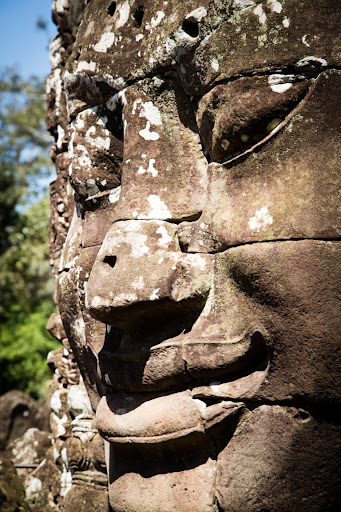
Bayon up close
- Many of the walls of the Angkor Wat temple are peppered with holes. These are not construction marks but mainly bullet scars and indentations from the battles between the Khmer Rouge and government forces from the civil war (1975-1979).
- Thanks to international aid, security, and conservation efforts, the Temples were removed from UNESCO’s “Danger” list in 2004.
- The temples are protected by Royal Decree and were added to the UNESCO Work Heritage list in 1992.
- Images sent from NASA through in the year 2000 greatly expand our knowledge of the temples, and areas previously thought deserted were shown to have forgotten remnants.
- The first temples were constructed in the early 9th century right up until the 15th century until they were deserted. It was not just a remote temple complex - Angkor and its surrounding city was home to up to 1 million people and was, for a time, the world’s largest metropolis. This is especially impressive, given the harsh jungle surroundings.

Transport to the temples
- Using a vast moat (also of Hindu religious significance) and canal system, the Khmers produced a complex irrigation system far beyond what early archaeologists had predicted, and much of it continues to baffle scientists and anthropologists today. Unfortunately, some scientists believe that this irrigation system (due to the increasing build-up of sediment in the rivers) may have actually helped bring about the city’s demise, as water issues impacted rice harvests.
- Other hypothesis as to the city’s demise include invasion from the Siam empire (modern day Thailand) which appears to have dealt the hammer blow in the 15th century. Other theories revolve around new trade links with China and a subsequent need for the city to move closer to the Mekong and South China Sea. Others cite the rise of the more egalitarian religion of Theravada Buddhism, which was slowly replacing the dominant Hinduism and may have threatened the highly subversive and absolute rule of the monarchy.
- King Jayavarman the 2nd was the Khmer Empire's most celebrated king, mainly for his humanitarian work within civil society and his building of the iconic temples of Angkor Thom (itself a walled city and much larger than most in Medieval Europe) and Bayon. The latter is famed for its large smiling faces which are believed to be the face of King Jayavarman the 2nd himself.
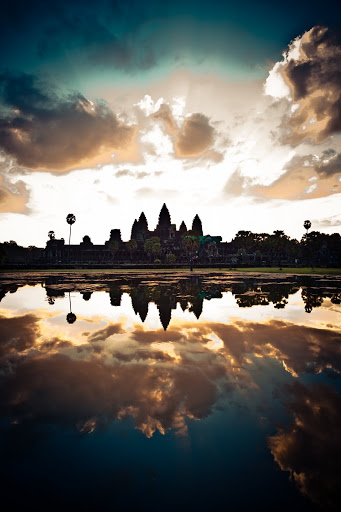
Angkor Sunrise
- The 11th century temples (famed for being built up over three floors) were saved by French archaeologists. From the 1960’s – broken up by Cambodia’s civil war – the temple's 300,000 blocks were numbered and reassembled in what was referred to by the BBC as the world biggest puzzle.
- Monks from the Society of Hinduism renamed Ta Prohm “Angelina Jolie temple” as a thank you for bringing the temples to global fame. Ta Prohm is famed for its jungle-tangled appearance and towering trees which have grown out of the temples ruins.
- Each year, the temples of Angkor host a half marathon and contestants enter from around the globe.
- Although now completely cleared, the Khmer Rouge – as they did across Vietnam - indiscriminately planted landmines throughout the temple complex.
Bio:
Kian is Travel Indochina’s e-commerce executive who has now left the Oxford office and relocated to their Sydney office and he’s lucky enough to have travelled extensively through Vietnam, Cambodia, Laos & Thailand and many others. His favourite activity remains the joy of sitting on one of those little plastic street-side chairs you only find in Asia with a beer, people watching, writing and occasionally nodding off. You can follow him @41jessi or via the @travelindochina account.
All photos courtesy and copyright Kian, Travel Indochina



















